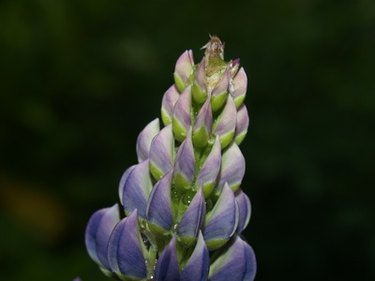
Lupine plants (Lupinus spp., USDA plant hardiness zones 3 to 7) have colorful spikes with blue, yellow, purple and pink blooms. Some species of lupines are classified as invasive, but they are so pretty that instead of killing them, transplanting them is an option if you are careful. Of course, you may want to transplant them for other reasons, such as moving one from a pot to a garden. Mature lupine plants are known for being hard to move because of their long, vertical taproot systems.
Planting and Moving Lupine Plants
Video of the Day
To move lupine plants from peat pots to outdoors, begin by preparing a garden bed that receives full sunlight and till the top 10 inches of soil. These plants do best in moist, sandy, well-drained soil and prefer cool temperatures. You can try laying a 2-inch layer of compost on top and digging planting holes 18 inches apart that are a bit wider than the lupine peat pots.
Video of the Day
Then, remove the top of the peat pot so the rims will be even with the pot's soil surface. Place the peat pot into the hole with the rim even with the soil.
Add soil around the peat pots but do not cover the soil that is in the pot. Water immediately and keep the soil moist but not soggy. The peat will break down into the soil, and the lupine will spread its roots.

Transplanting Lupine Plants
There are more than 200 species of lupines, and while some are annuals, others are perennials. Most have a woody taproot, which makes them harder to move. The roots can be easily damaged during the moving process, so extra care and patience is required.
Most perennial lupines can be moved at any time throughout the growing season, but it is crucial to work as quickly as possible. It is also recommended to dig the new planting holes before digging up the lupine because the roots start to decay when they are exposed to air. Their taproots can grow down 20 inches, so gently loosen the soil with a garden fork or rototiller.
Once the lupine is in the ground, it can be watered. The soil should be kept evenly moist, and you can try applying fertilizer once every four weeks in the summer. Wilted flowers can be cut off but do not trim off the dead spikes until early the following spring. Lupines can get pretty tall, so you may need to stake the plants.
Lupine Propagation and Seeds

Lupines do not usually propagate well from cuttings, so the best thing to do is to use their seeds. If this is what you want to do, avoid deadheading or pruning and let the flowers form seedpods. When these pods turn yellow and the seeds rattle when the pods are shaken, they can be picked. After a few weeks, the seeds can be extracted from the plants and kept in a dry place until the next planting season.
There are some perennial lupine species that can be propagated from cuttings. These should be taken in the spring from the shoots growing at the base. You can try using a rooting hormone but be aware that lupine cultivars do not always keep their original flower colors if and when they bloom.